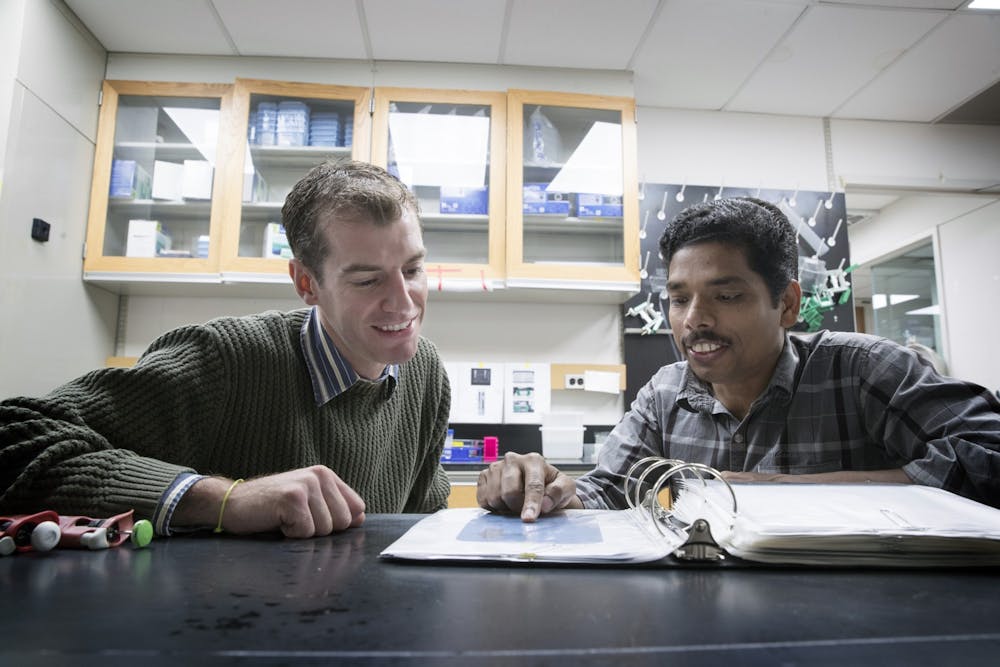To better learn about what our genes can do, researchers have recently used a plant hormone to make improvements to a decade-old system for degrading proteins. The work, published in a paper in August, was done in the Department of Biochemistry and Molecular Genetics by Asst. Prof. Michael Guertin and research scientist Sathyan Mattada. The lab has a $1.25 million grant distributed over five years from the NIH, part of which has been used towards their work on the degron system.
The changes can help scientists better learn about individual gene function and is often a more stable and effective approach than the common method of repressing a gene’s expression. The system could expand scientific knowledge of genes, as well as medical research, such as drug discovery.
Genes are sequences of DNA passed down from generation to generation that contain instructions for making proteins. Proteins have a variety of functions in cells — the smallest units of life — including expediting metabolic reactions, helping signal between cells and providing structure to cells. When a gene is expressed, its instructions are read and proteins matching those instructions are made.
A natural question that molecular biology researchers ask is what a certain gene does. A technique scientists often use to answer this question is seeing how a cell behaves without the gene of interest. Guertin explained this concept by drawing an analogy to a car.
“If you're driving a car normally, and you pull out the radiator, you can easily, by looking at your gauges, see that it makes the car gets hotter,” Guertin said. “And that's why we want the cell to be operating normally, get rid of one thing and observe immediately what happens.”
To remove a gene from the cell, scientists can permanently inactivate the gene or non-permanently repress its expression. However, these actions can sometimes prove to be fatal for the cell’s overall function and hence make it difficult to study the gene’s function.
Instead of taking these approaches and affecting the gene — the DNA — itself, Mattada explained that is easier to directly target a gene’s protein through a process known as the degron approach, in which a plant protein called AID and another plant gene are added to the target gene. The hormone auxin — which is found in most plants, according to Guertin — degrades the proteins made by the targeted gene.
The problem in that system, Guertin said, is that the gene is expressed at much lower levels, meaning that there is little protein produced. This “leaky” issue would not help scientists glean the possible function of the gene.
“If you have 10 percent of something and get rid of the rest of it, that's not as robust — you can't really observe what that does as well as if you have 100 percent of it and you reduce it to one percent,” Guertin explained.
The lab initially took a year to develop the old system only to realize it did not work well due to the “leaky” problem. They then took another year to come up with their improvement, which involves adding another plant protein, called ARF, to the system.
Mattada explained that while the old system caused low levels of expression, ARF allows the gene to function at its normal level until the hormone is added, at which point the proteins can be degraded.
“I started to read about these plant pathways,” Mattada said. “So I suddenly got this idea, when I read about these pathways, I sensed this component is missing.”
Mattada explained that the system allows researchers to study the immediate effects of the protein degradation, and both Guertin and Mattada said that it is most directly useful for basic research — answering the question of what certain genes do.
“Figuring out molecularly what that gene [associated with a disease] does and how it's contributing to the disease is just generally important for basic research,” Guertin said.
The system can also be applied to drug discovery. Guertin explained that a significant challenge in drug discovery is specificity to the target, since a drug can affect not only its intended target, but also other molecules in the cell. Guertin explained that the degron system can help scientists compare a potential drug’s expected and actual impacts.
Guertin and Mattada said that the lab is currently using the degron system to study transcription. Mattada added that they are using both HEK cells, a cell line that is easy to genetically edit according to Guertin, as well as breast cancer cells. The lab is interested in studying estrogen signaling and hopes to answer questions such as why estrogen activates the transcription of some genes but not others.







